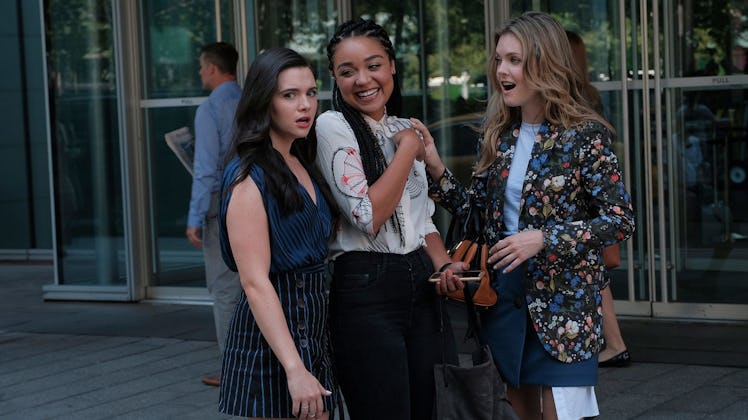
‘The Bold Type’ Gets A Lot Wrong About Millennial Women & That's Why You Should Watch It
There's a storyline in Season 2 of The Bold Type that sets out to tackle America's gun control issue. In the episode, Sutton (Meghann Fahy) reveals to her roommate and best friend Jane (Katie Stevens) that she's been secretly keeping a gun in their apartment. She was on her high school shooting team and strongly believes in the Second Amendment; meanwhile Jane isn't comfortable with a gun in her home. They have a healthy debate, but in the end, Sutton decides to get rid of her gun... and turn it into a piece of jewelry. It's the kind of fix that not only solves the issue, but also does so in a fun, easy-to-swallow fashion. The issue is solved with an adorably feminine simplicity that is unlikely to occur in real life. It's just one example of the many unfeasible plot points on the show. The Bold Type gets a lot wrong about millennial women, but that's not necessarily a bad thing. In fact, that's exactly why you should watch it.
On The Bold Type, problems are usually solved pretty easily for the main characters. Jane, Sutton, and their third bestie Kat (Aisha Dee) all work for a fictional Cosmopolitan-type magazine called Scarlet. There, they dress in designer clothes even though they work entry-level jobs, while the social media manager tweets on the fly off her phone instead of heavily planning and scheduling posts. Jane constantly turns stories in directly to the editor-in-chief Jacqueline (Melora Hardin), and also benefits from Jacqueline's heartfelt guidance and advice. It's nothing like a real workplace, but it sure does sound idyllic.
Why wouldn't I want to live in a world where my boss is not only my mentor, but also my confidante and surrogate mom? It's the dream of Shine Theory come true in an easy-to-consume form. Life would be blissfully easier if I could find the professional and personal advice I need just by walking down the hall of a beautiful open-plan office. Instead, my peers and I drive in rush hour traffic or take multiple subways to attend networking events where we're lucky to get five minutes with a potential mentor. And that's not the only unrealistic story point. Everything from the characters' rental apartments to the ways they use technology is treated with a level of ease that would never exist in real life.
But just because The Bold Type makes life easy for its characters doesn't mean the series is bad or that it should change. On the contrary: The idealized world of the series not only provides an easy escape, but it also provides hope to its viewers.
Over the course of its three seasons, The Bold Type has covered a wide range of hot-button issues, from gun control to sexual assault to racism to LGBTQIA+ life. A lot of the time, storylines are tied up in ways similar to the ways Sutton's gun storyline was completed. Issues often aren't fully dissected or examined; instead, they're more neatly tied up. Problems that aren't very easy to solve in the real world end up having a clear conclusion on The Bold Type — and that's actually a good thing.
It's an immense pleasure to watch a show that first acknowledges the world's issues and then allows viewers to escape them. The Bold Type presents a version of the world where everything is solved relatively easily with a fun photoshoot and a hashtag. Millennials grew up with LiveJournals and Twitter and blogs. They grew up online, constantly speaking up and feeling the potential for their voices to make a difference in a big media landscape. In the real world, though, speaking up can feel futile in practice. So many voices can drown each other out. But on The Bold Type, that dream of making a difference comes true, and that's exhilarating to watch.
All the elements of real life are there on the series, but they're filtered through millennial, rosé-colored glasses. The characters' lives looks familiar enough, but with the ease and glossiness of a fantasy that smooths out any sharp edges. It's like playing with Barbie dolls for millennials — the same way little kids use dolls to play make believe and gesture toward an aspirational future in broad strokes, millennials can watch The Bold Type and imagine how their dream world might look.